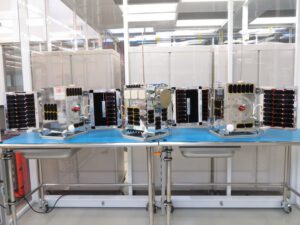TORONTO, Ontario, Canada – Space Flight Laboratory (SFL) announced that ground control successfully established communication with three radio frequency (RF) geolocation microsatellites developed by SFL for HawkEye 360 of Herndon, Va. Cluster 6 was launched 24 January 2023 on the inaugural flight for Rocket Lab’s Electron Rocket from Wallops Island, Va. This successful mission brings the number of HawkEye 360 microsatellites built by SFL and now in orbit to 18.

HawkEye 360 Cluster 6 microsatellites in the SFL cleanroom.
The HawkEye 360 Constellation detects and geolocates RF signals for maritime situational awareness, emergency response, national security, and spectrum analysis applications. To boost revisit rates over the mid-latitude regions of the globe, Cluster 6 was launched into an inclined orbit. Upon commissioning, HawkEye 360 will be able to collect RF data as frequently as every hour anywhere in the world.
HawkEye 360 selected SFL due to the importance of formation flying by multiple satellites for successful RF geolocation. Clusters 2, 3, 4 and 5 have all been built on SFL’s space-proven 30 kg DEFIANT microsatellite bus. SFL’s formation flying technology enables the Virginia company to offer the most timely and actionable RF data and data analytics available on the market.
“Cluster 6 launched as planned to support expansion of the HawkEye 360 constellation as it scales to meet the growing worldwide demand for its commercial RF data and analytics services,” said SFL Director Dr. Robert E. Zee. “SFL’s trusted attitude control and formation-flying capabilities deliver the stability and accuracy required for precise RF geolocation.”
SFL is a unique microspace provider that offers a complete suite of nano-, micro- and small satellites – including high-performance, low-cost CubeSats – that satisfy the needs of a broad range of mission types from 3 to 500 kilograms. Dating from 1998, SFL’s heritage includes 64 operational successes with more than 225 cumulative years of operation in orbit and 28 currently under construction or awaiting launch.
These missions relate to Earth observation, atmospheric monitoring, ship tracking, communication, radio frequency (RF) geolocation, technology demonstration, space astronomy, solar physics, space plasma, and other scientific research, utilizing core SFL-developed components such as modular (scalable) power systems, onboard radios, flight computers, and control software.
About Space Flight Laboratory (SFL) (www.utias-sfl.net)
SFL generates bigger returns from smaller, lower cost satellites. Small satellites built by SFL consistently push the performance envelope and disrupt the traditional cost paradigm. Satellites are built with advanced power systems, stringent attitude control and high-volume data capacity that are striking relative to the budget. SFL arranges launches globally and maintains a mission control center accessing ground stations worldwide. The pioneering and barrier-breaking work of SFL is a key enabler to tomorrow’s cost-aggressive satellites and constellations. (www.utias-sfl.net)
Download the specification sheet for all SFL platforms here.